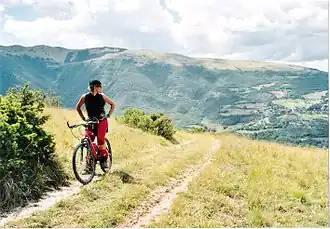Healing power of nature
| Resource type: this resource contains a lecture or lecture notes. |
| Completion status: this resource is ~25% complete. |
These notes are based on a guest lecture for the Health Psychology unit of study at the University of Canberra.
Overview
This lecture provides an introduction to the "healing power of nature" from a psychological point of view. It emphasises psychoevolutionary theory and practical applications.
Activities
This section involves some experiential activities to heighten personal awareness about our engagements with nature.
Sensory awareness inventory
Write down as many examples as you can of how you receive pleasure, comfort or enjoyment through each of your five senses:
| Sight | Sound | Touch | Taste | Smell |
|---|---|---|---|---|
|
|
- Discussion
Favourite place in nature
- Close your eyes
- Take a deep breath in … and out
- Imagine your favourite place in nature
- See yourself visiting that place
- What does it feel like?
- When you’re ready, say goodbye and leave that place
- Then open your eyes
- Find a person near you and share about your favourite place
History
This section looks at the role of nature in health and well-being through human history.
Indigenous
- Humans lived deeply in and with nature for hundreds of thousands, if not millions of years
- Thinking, feeling, and behaving was intimately connected to natural environments (land, air, water, plants, animals, weather, ecosystems)
Industrialisation
- 1000 - 10,000 years ago: Many indigenous cultures became agrarian (farming-based) – Agrarian society (Wikipedia)
- Present - 250 years ago: Many agrarian cultures became industrialised (manufacturing economy) – Industrialisation (Wikipedia)
Present
- Many people do not live in direct, continuous, daily contact with nature.
- Urbanisation:
- 2018 = 55%
- 2050 = 68% [https://www.un.org/development/desa/en/news/population/2018-revision-of-world-urbanization-prospects.html
- Nature deficit disorder (Wikipedia) (Louv, 2008)
Future
- ↑ Urbanisation
- ↑ Human population
- ↓ Natural environment
- → ↑ Nature deficit disorder?
Theory
This section explores the main psychologies theories used to understand the healing potential of nature.
Intersections
This area represents intersections between:
- Health
- Environment
- Psychology
Psychevolutionary theory
- Evolutionary psychology (Wikipedia)
Biophilia hypothesis
- Biophilia hypothesis (Wikipedia) (Wilson, 1984)
- Edward O. Wilson's Biophilia Hypothesis (wilderdom.com)
Attention restoration theory
- Attention restoration theory (Wikipedia)
- Attention restoration theory (Motivation and Emotion Book Chapter, Wikiversity)
- Attention restoration theory (Psychology of natural scenes, Wikiversity)
- Kaplan (1995)
Stress reduction theory
- Stress reduction theory (Wikipedia)
- Stress reduction theory (Psychology of natural scenes, Wikiversity)
- Ulrich et al. (1991)
Research
This section highlights some key and illustrative research findings about the healing potential of exposure to nature.
Natural scenes
- Ulrich (1984): Natural view through a hospital window promoted recovery
- Viewing
Green space
- Public health
Green exercise

- Field studies
- Lab studies
- MMORPG exergames
Nature therapy
- Nature therapy / ecotherapy
- Adventure therapy
- Animal therapy (e.g., companion animals, equine therapy, mini-zoo keepers)
- Conservation therapy (e.g., mini zoo-keepers)
- Green prescriptions (GRx)
- Horticultural therapy
- Nature meditation
Summary
Slides
- Healing power of nature, 2019 (Google Slides)
See also
- Activities (more)
- Green exercise
- Psychology of natural scenes
- Future directions
Readings
Bowler, D. E., Buyung-Ali, L. M., Knight, T. M., & Pullin, A. S. (2010). A systematic review of evidence for the added benefits to health of exposure to natural environments. BMC Public Health, 10, 456. https://doi.org/10.1186/1471-2458-10-456
Frumkin, H. (2001). Beyond toxicity: Human health and the natural environment. American Journal of Preventive Medicine, 20, 234–240. https://doi.org/10.1016/S0749-3797(00)00317-2
Gullone, E. (2000). The biophilia hypothesis and life in the 21st century: Increasing mental health or increasing pathology? Journal of Happiness Studies, 1(3), 293–322. https://doi.org/10.1023/A:1010043827986
Kaplan, S. (1995). The restorative benefits of nature: Toward an integrative framework. Journal of Environmental Psychology, 15(3), 169–182. http://doi.org/10.1016/0272-4944(95)90001-2
References
Maas, J., Verheij, R. A., Groenewegen, P. P., De Vries, S., & Spreeuwenberg, P. (2006). Green space, urbanity, and health: how strong is the relation? Journal of Epidemiology & Community Health, 60(7), 587–592. http://doi.org/10.1136/jech.2005.043125
Ulrich, R. S. (1984). View through a window may influence recovery. Science, 224(4647), 224–225. http://doi.org/10.1126/science.614340
Ulrich, R. S., Simons, R. F., Losito, B. D., Fiorito, E., Miles, M. A., & Zelson, M. (1991). Stress recovery during exposure to natural and urban environments. Journal of Environmental Psychology, 11(3), 201–230. https://doi.org/10.1016/S0272-4944(05)80184-7
Wilson, E. O. (1984). Biophilia. Harvard University Press.